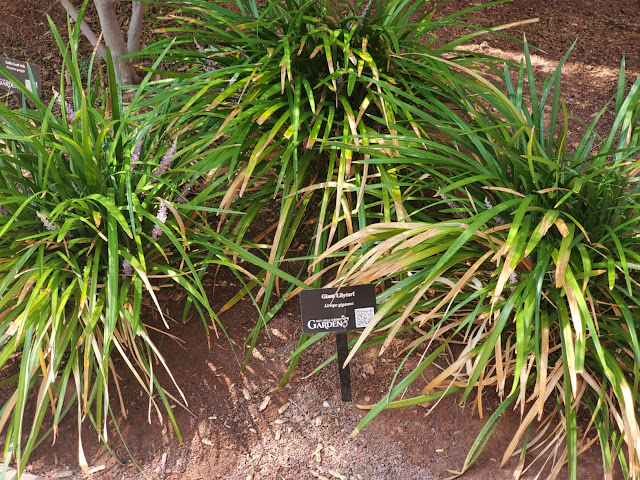One thing I love about St. George, Utah, is that they really want to help you design a sustainable desert garden. They have two desert gardens that contain plants that thrive in our climate and they provide all the info you need to design a garden. And I desperately need the help. Our summers here just keep getting hotter and this Autumn I need to replace the plants that didn't survive.
 |
| The Red Hills Desert Garden has a beautiful layout and includes zones for different types of desert plant |
 |
| Modesto Ash (Fraxinus velutina 'Modesto,'). |
First of all, the garden is broken up into zones, such as yuccas, agaves, and flowers. They even have a canyon in the center with some shade-loving plants. Each plant is marked with its common and Latin names and has a link for more information. It really is awesome.
I have tentatively picked some plants that I will use. I might change my mind before Autumn, but at least I have a starting point.
I really want to plant a Modesto Ash (Fraxinus velutina "Modesto") in the front garden where the Bradford pear was. It is a stronger tree, is more drought tolerant, and it grows faster. We really need a good shade tree. The front of the house faces west and the afternoon and evening sun is brutal.
 |
| Color Guard Yucca (Yucca filamentosa "Color Guard") |
Also in the front garden are four chrysanthemum bushes that just look sad. Technically they survived, but they are wilted and pathetic. They only bloomed once in the two years they have been in the ground and those blooms were barely two inches across. I am taking them out and I plan to replace them with Color Guard Yuccas (Yucca filamentosa "Color Guard"). The Color Guard is one of the smallest yuccas and it is the only one I could find that doesn't have dangerously spiky or sharp leaves. It will be right next to the front sidewalk so the small size and lack of pointy things is important.
 |
| Artichoke Agave (Agave parryi var. truncata) |
Another choice for the front garden is the Artichoke Agave (Agave parryi var. truncata). Like with the Color Guard Yucca, it is one of the smallest of its species so it won't outgrow the narrow space. And the leaves curve in so the ouchie parts are contained. Most agaves grow up and out, which again can be dangerous next to a sidewalk.
 |
| Giant Lily Turf (Liriope gigantea) |
For the back garden, I need some plants to replace my dead Mock Orange and Columbines underneath the Wisteria. It is mostly shady thanks to the Wisteria's canopy, but thanks to the heat and water restrictions, they just didn't make it. The only survivor is the Star Jasmine on the back wall. I am thinking of putting in three or four Giant Lily Turfs (Liriope gigantea). They make pretty mounds and have nice lavender flower spikes. And they should love the shade.
 |
| Desert Zinnia (Zinnia grandiflora) |
I am also thinking of adding a couple Desert Zinnias (Zinnia grandiflora) where the shade gives out and we get more sun. It has gorgeous yellow flowers and it can take the heat. They are supposed to bloom all Summer and Autumn, so they should be a nice dash of added color.
I am also pondering some White Rain Lilies (Zephyranthes candida) or Yellow Rain Lilies (Zephyranthes sulphurea) to add some color in another shaded corner. These are bulbs, which seem to do well in my back garden, and they also bloom Summer and Autumn. Plus the leaf shape would contrast nicely with the Trumpet Vine.
 |
| Bonus photo - a chipmunk stuffing his cheeks with Mesquite seeds. |
As soon as the weather cools a bit more I will begin cleanup of the outside gardens. Once I have a better idea of what spaces need filling I will probably do another round of the desert garden and then hit the nursery. It will be a busy Autumn but hopefully I will end up with a more heat-tolerant garden next summer.

No comments:
Post a Comment